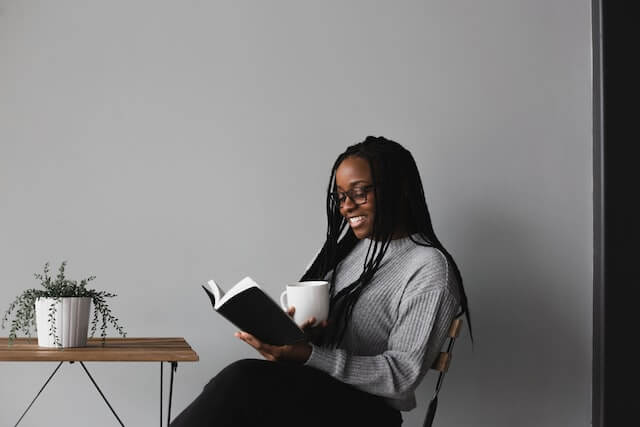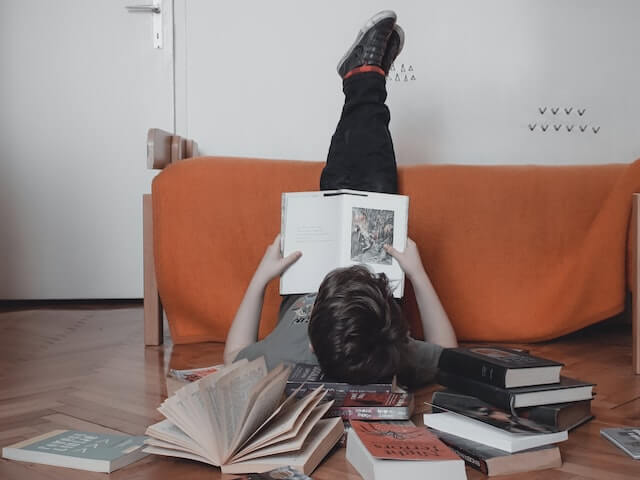This post may include affiliate links – check our Privacy Policy
There’s no one best reading position or correct posture to do it, but there are definitely some positions that are better for your posture, your breathing, and your overall comfort.
Table of Contents
Top 5 reading positions
Sitting position

Although sitting might not be the most comfortable reading position, it’s by far the most common.
You can also try lying down while holding your book with both hands or propping one arm on an armrest while resting the other over your book.
If you want to read a book while your feet are up, you can do so in a variety of positions. You may even be able to cross your legs with your book in your lap. With really comfy chairs and couches, you can slouch slightly and rest your elbows on the armrests.
The setting doesn’t always determine how the reader is going to sit. You might want to hunch over your desk and get work done, or you might want to recline against a favorite tree or person.
Just be careful that they are comfortable with your weight leaning against them for a few hours (or don’t bother!)
Supine position

A lot of people say that the best position for reading is lying on your back. There are a few reasons it deserves to be the number one reading position.
It’s very relaxing – you’re completely disconnected from everything else and focused on the book. This is a good posture to relax your muscles.
Also, this reading position will help you if you are reading a book at a late time and it’s hard for you to shut down yourself.
Although there’s the problem of decreased visibility – you can’t always read the small text at this angle without a light source behind you.
Standing position

Reading on your feet is a great way to get some reading done in situations where you can’t just sit or lay down.
Standing up is the most practical position, especially when you know you’re going to have to pack up soon and head off.
Stand for shorter sessions and lean against something nearby for more comfortable long-term reading.
If you’re crossing the street, though, it’s best not to simultaneously walk and read!
Side position

Lying on your side can be a comfortable position though you might roll onto your back again eventually.
Lying on one side might be nice if you don’t want to lie flat and have one arm out in front of you, or if you’re lying on your back with one arm propped under your head, or curled up in the fetal position with your knees to her chest.
One problem with this position is that it can be difficult to continue reading as your arm starts to slip and you start to get a headache. But it gets bonus points for being the perfect way to curl up with a book.
Prone position

Lying on your stomach can be pleasantly comfortable but there’s not a great way to hold the book. If you lie flat and stretch the book out in front of you, it’ll end up making your neck cramp painfully. And this neck pain can stay for a while.
You can hold the book in your lap, with the lower back arched. You could also prop yourself up on your forearms, like a cobra with the book in front of you.
This gives your lower back a nice stretch, but it might fatigue you after a while. Reading on your stomach is ranked last because it’s mostly a waypoint between other more comfortable positions.
Which posture is best for reading?
When it comes to finding the correct posture for reading, it really depends on the individual. Some people find that lying down flat on their back with a book propped up on their chest is the most comfortable position, while others prefer to sit upright in a chair with their feet planted firmly on the ground.
There are also those who like to read while reclining on a couch or lounge chair. Ultimately, it’s up to the reader to experiment with different positions until they find the one that feels best for them.
How do you read without hunching over?
Assuming you’re talking about reading without hunching over a book, there are a few things you can do to make this happen.
One is to make sure the spine of the book is relatively straight – this will help to keep a good posture and keep you from hunching over. Another is to sit up straight in your chair, keeping your shoulders back and down.
You may also want to prop the book up on something so that you’re not constantly bending over it.
Finally, take breaks often to stretch and move around – this will help keep your muscles from getting too tense and prevent you from hunching over.
Is it better to read sitting or lying down?
There are pros and cons to both readings sitting and lying down.
Some people find that they can concentrate better when sitting up, while others find that lying down is more comfortable and allows them to focus more on the story.
Ultimately, it comes down to personal preference and what works best for you.
What is the proper posture to read a book at a desk?
Assuming you are reading a book at a desk, the proper posture to maintain would be sitting up straight in your chair with your feet flat on the floor.
Your hands should be resting on either side of the book, and your head should be level with the spine of the book. You should be looking down at the book at a slight angle, about 10-15 degrees.
How to Make Reading in Bed More Comfortable
There are a few things you can do to make reading in bed more comfortable:
- First, make sure you have a good pillow to support your neck and back. This will help with your possible neck pain if you are reading a lot.
- Second, adjust the light so that it’s not too bright or too dim.
- Third, find a comfortable position that doesn’t put too much strain on your neck or back. By that, you will have proper blood circulation.
- Fourth, if you’re using a tablet or e-reader, invest in a case or cover that will protect your device from getting dropped.
What is the best way to read in bed?
There are a variety of ways to read in bed, and what works best may depend on the reader’s preferences and the type of book they are reading.
For example, those who enjoy sci-fiction might want to curl up with their book and read lying down, whereas someone reading a textbook about history might prefer to sit up in bed with a pillow supporting their back to be more focused and to have an extended period of reading.
One way to find the most comfortable position is to experiment until you find what works best for you. Proper reading posture is a very individual thing, so let yourself test all of it.
Start by trying different positions – lying down, sitting up, leaning against the headboard – and see how each feels. Maintaining proper posture will increase your focus and reading time.
Pay attention to your body and how it feels after reading in each position for a while.
Many people talk about a poor posture effect to reader’s blood circulation, which may cause some negative effects on your body and mood. To avoid this, try using different pillows or props to support your arms or back.
Once you’ve found a position that is comfortable and allows you to focus on your book, stick with it!
Reading should be enjoyable, so finding a position that works well for you will help make the experience more enjoyable overall.
How does reading before bed affect your sleep?

Most people tend to read in bed before they sleep, but did you know that reading in bed could be affecting your sleep?
Research has shown that reading in bed can make it harder to fall asleep and stay asleep.
So why does reading in bed affect your sleep? The main reason is that when you’re reading, you’re actually stimulating your brain. This means that your brain is less likely to shut down for the night, making it harder to fall asleep.
Additionally, if you’re reading on a bright screen (like a tablet or e-reader), this can also affect your sleep. The blue light from these screens can disrupt your body’s natural circadian rhythms, making it harder to fall asleep and stay asleep.
If you want to read before bed without disrupting your sleep, there are a few things you can do.
- First, try reading with a physical book instead of a screen. This will help reduce the amount of blue light exposure you get. Or listen to an audiobook, here is the list of free audiobook providers.
- Second, try reading in bed with dim lighting instead of bright lighting. This will also help reduce the amount of stimulation to your brain and make it easier to fall asleep.
Finally, reading in bed can harm your sleep, but at the same time for some people, it helps to sleep. The main reason why it helps, they read boring books, which is the same tactic as counting sheep before sleep.

